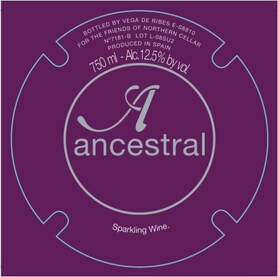Vega de Ribes, a small family producer since the 1500's, is justly proud of its organic grapes and wines from estate vineyards that are located on the limestone soils of the Garraf mountain range, just 4km from the Mediterranean Sea. Producing a range of remarkable wines, their white wine production is truly an outstanding effort, showcasing some of the best that Penedés has to offer. Enric Barta has carried the torch of his ancestors far beyond where they may have imagined, as he took to the local grapes with great foresight, imagination, and immense respect. He was awarded the first Slow Foods Presidia Award ever given to someone for his or her work with a grape variety (the Presidia Project is dedicated to products that are nearing extinction), as he cultivated the few remaining plants of Malvasia de Sitges in the area (boasting history in the northeast of Spain for well over 500 years), back to health and great propagation. Taking this grape, Xarel.lo, and some Tempranillo as well, the wines of Vega de Ribes are elaborated naturally, with minimal (if any) sulfur use, spontaneous fermentations, and a wild terroir characteristic that is distinct and truly special.
vega de ribes 'ancestral'
100% ull de llebre (tempranillo)
The Ancestral line of wines has been one of Vega de Ribes’ creative projects for nearly 20 years now, following the Ancestral Method for sparkling production and pre-dating the ‘pet-nat’ trend that has made this style so famous. Over the years they have honed their craft to achieve the perfect amount of pressure to offer enticing bubbles, while maintaining the right amount of delicious fruit and character, depending on the grapes in the bottle. This Ull de Llebre (Tempranillo) is a gorgeous example of everything going right, having begun a natural fermentation in stainless steel and then moved to finish in the bottle when the sugar is at 24g/l. After 22 months of aging on lees, it was disgorged and corked to release for sale in very limited quantity (900 bottles!). The aromas are packed full of ripe wild strawberries, cranberry, red apple, and an alluring musky earthy tone that mixes with the release of CO2; all of which leads to a vibrant and bubbly palate loaded with red berries and tangerine, yet has a tannic grip that is backed with bitter almond, rose petals, and sweet tobacco spice.
100% ull de llebre (tempranillo)
The Ancestral line of wines has been one of Vega de Ribes’ creative projects for nearly 20 years now, following the Ancestral Method for sparkling production and pre-dating the ‘pet-nat’ trend that has made this style so famous. Over the years they have honed their craft to achieve the perfect amount of pressure to offer enticing bubbles, while maintaining the right amount of delicious fruit and character, depending on the grapes in the bottle. This Ull de Llebre (Tempranillo) is a gorgeous example of everything going right, having begun a natural fermentation in stainless steel and then moved to finish in the bottle when the sugar is at 24g/l. After 22 months of aging on lees, it was disgorged and corked to release for sale in very limited quantity (900 bottles!). The aromas are packed full of ripe wild strawberries, cranberry, red apple, and an alluring musky earthy tone that mixes with the release of CO2; all of which leads to a vibrant and bubbly palate loaded with red berries and tangerine, yet has a tannic grip that is backed with bitter almond, rose petals, and sweet tobacco spice.
